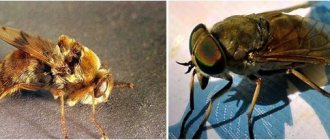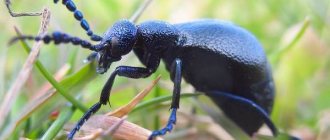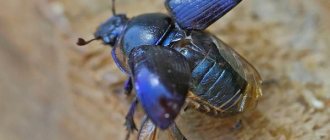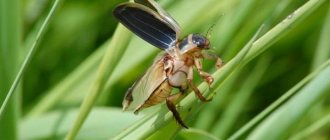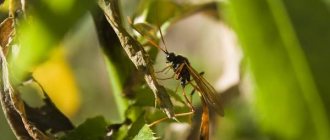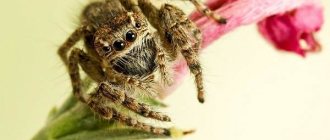The onset of spring brings not only excellent weather, outdoor picnics and walks, but also such an unpleasant phenomenon as the activation of ticks. Ticks are small arthropods from the order of arachnids that have lived on the planet for several million years. Since they live mainly in the soil, the period of their activity occurs when it warms up to +5 degrees. Many of the representatives of this subclass are carriers of severe diseases such as tick-borne typhus, encephalitis and borreliosis. The number of species of mites is amazing and is recorded at approximately 50 thousand, but researchers divide the subclass itself into three groups: harvest mites, parasitiform and acarimorph mites.
Types of ticks
For many, “ticks” are only those that live in the forest and bite animals and people. But in nature there are a huge number of ticks, divided into species and differing in diet and lifestyle. We will now look at some types of mites. The classification of mites distinguishes three independent orders.
- Grasshopper mites
is a species of arthropod that lives in the tropics and subtropics. The name comes from the structure of the hind legs, which, with their long and massive appearance, resemble haymakers. The tick itself reaches a size of up to 3 mm and is considered one of the largest among its fellows. His head is combined with his chest, forming a single part, separated from the belly. The diet of such mites includes fungal spores, pollen and other smaller insects. - Parasitiform mites
are the most dangerous species, including parasites of vertebrates, predators, and saprotrophs (organisms that serve to destroy the remains of living beings). It is these ticks that are carriers of diseases, in most cases leading to disability or death. - Acarimorphic mites
- this largest group includes about 15 thousand species, half of which parasitize vertebrate animals. This explains their diet - skin, hair, feathers. The size is extremely small, usually does not exceed 0.3 mm, however, not only the head, but also the abdomen is divided into segments. This group also includes disease carriers, but in smaller numbers.
In addition to the three main and collective groups into which scientists classify ticks, there are many other species. Let's look at the most common ones:
- Ixodid ticks
in most cases they are carriers of encephalitis. Particular activity occurs in May-July; insects live in grass or bushes and it is from the vegetation that they fall on humans. Moving from below, the tick looks for a suitable place with thin skin, most often the wrists, neck, and head. - Argasid mites
They differ from other species in that they hunt all year round. They live in dark and hard-to-reach places, such as nests, caves and various cracks. If there is a lack of blood intake, argasid mites hibernate. However, it only takes them half an hour to be completely saturated with blood, and only a minute to infect a victim with a serious disease. - Subcutaneous mites
live under human skin, as their name suggests. They develop and live under the skin for quite a long time until they are hatched, feeding on dead cells. Acne, itching and severe redness occur at the affected areas. Infection occurs from carriers of the disease through towels, touches and personal hygiene items. - Scabies mites
capable of moving from animal to person, causing a disease such as scabies. Infection from other people through household items, especially bedding and combs, is also common. - Bed dust mites
live in pillows, blankets and mattresses, feeding on dust and exfoliated particles of dead epidermis. They do not feed on human blood and are not capable of biting. It is impossible to see dust mites with the naked eye; they are microscopic. Very often they are confused with bed bugs, which feed on human blood. - Spider mites
They live on plants, feed on their sap and entangle them in their web. Plants wither and die if measures are not taken in time.
Barn mites
(Acaridae), also called mealies, or bread-bearing animals, are small animals with gnawing chelicerae. They live in soil and rotting plant debris, as well as in storage facilities for agricultural products, sometimes causing spoilage of grain, flour and cereals. Along with them, the pot-bellied tick ( Pyemotes
[
Pediculoides
]
ventricosus
) is a parasite of grain moth caterpillars and other granary insect pests that also attacks humans. In people who work with grain, it is capable of causing severe skin irritation and respiratory symptoms characteristic of allergic reactions through injections of the chelicerae. However, the pot-bellied tick quickly leaves a person, as it feeds on insect tissue.
What does a tick look like?
All these types of ticks look different. Only a few small individuals reach a size of 4 mm, but generally their average size is 0.1-0.5 mm. The body is of two types: an fused head and chest, turning into the abdomen, and a body with a hard shell.
Animal ticks do not have eyes, but are endowed with a sharp sensory apparatus that allows them to perfectly navigate in any space. It is important to note that, like other representatives of arthropods, ticks do not have wings, so they are not able to fly or jump.
How do mites develop?
| Tick eggs |
Ixodid ticks have a complex development cycle, including four phases: egg, larva, nymph, adult (female and male). During all active phases of development, ticks (larva, nymph, female) feed on blood only once in their life, but absorb large amounts of it. So, the weight of a hungry female is 3-4 mg, and a well-fed one from 40 to 500, on average 160-350 mg.
Well-fed females, leaving the host-feeder, first fall to the surface of the soil litter or soil, and then crawl into its thickness, under dead wood, stones, roots, cracks, where their further development takes place. Depending on the air temperature and weather conditions, they begin to lay eggs after 2-3 weeks. The number of eggs is large, up to 3000, but more often 2000. The number of eggs is directly dependent on the volume of blood consumed: more well-fed individuals lay the largest number of eggs.
| Tick larva |
From the eggs laid by the female in the same year, and sometimes the next, small light yellowish larvae hatch, which are similar to adults, but have three pairs of limbs. They sit in a dense bunch and do not spread out. Only in the spring do they become active and attack small animals (wood mice, voles, shrews, etc.).
The larvae suck blood for 3-4 days, then fall off and hide in the thickness of the forest litter. The development of well-fed larvae lasts from two months to a year. Complex processes occur in their body. They moult and turn into nymphs. The latter are slightly larger and darker than the larvae, and have four pairs of legs. For further development, the nymph must attack some animal and suck on blood. These can be hares, hedgehogs, squirrels, water voles, hazel grouse and other animals. Nymphs suck blood for 3-4 days, after which they fall off and hide in the thickness of the forest floor, under dead wood, in soil microcavities, and there they turn into adult ticks - females and males. The development of well-fed nymphs lasts from two to three months to a year. Like larvae, they can overwinter in hungry and well-fed states.
| Tick nymph |
Adult ticks, as a rule, do not leave their shelters, but remain hungry for the winter. In the spring, in the first thawed patches, on last year’s grass, you can find active females and males. Males are found on animals in a non-attached or even sucked state, but there are no reliable cases of blood in their stomach.
Females attack cattle, less often dogs, sheep, pigs, goats, cats, and among wild animals they feed on moose, wolves, foxes, hares, etc.
Once on the human body or the fur of an animal, the tick searches for a suitable place for suction, which sometimes takes a lot of time (one hour or more). In humans, ticks most often attach themselves to the neck, chest, armpits, and groin folds. Special attention must be paid to these places during inspections.
Both types of ticks develop according to the three-host type: larva, nymph, and adult feed on different hosts and leave them after satiation. The duration of development depends on how quickly a host can be found. Since it sometimes takes a lot of time to search for and wait for them, only one phase has time to complete development during the year.
The entire life cycle, from eggs of one generation to eggs of another generation, lasts at least three years. These periods depend on air temperature, the nature of the forest landscape, the presence of feeders, and weather conditions. At the northern border of distribution, the life cycle of ticks lengthens significantly: for taiga ticks from 3 to 5 years, and for European forest ticks from 3 to 6 years. This is due to the presence of periods of developmental delay in winter, as a result of which molting, egg laying and hatching of larvae are suspended. In winter, ticks are inactive.
An important epidemiological feature of ixodid ticks is their exceptional individual longevity. In laboratory conditions at low temperatures, female European forest ticks lived for 27 months, and female taiga ticks lived for 1.5-2 years. And some southern species in the laboratory of E. N. Pavlovsky lived for more than 11 years, maintaining viability.
Tick development cycle: 1 - first host-feeder, 2 - well-fed female, 3 - eggs, 4 - hungry larvae, 5 - second owner, 6 - well-fed larvae, 7 - hungry nymph, 8 - third owner, 9 - well-fed nymphs, 10 - female and male tick.
Tick habitats
Ticks live in almost every corner of the world, with the exception of the most northern latitudes. Ground ticks prefer high humidity, so most often they live near water, in bushes, mosses, animal burrows or grass and fallen leaves.
There is an opinion that ticks live in trees and can fall on top of their prey at any moment. This is not true, because ticks are not able to climb to a height of more than a meter, so they prefer to hunt from the grass, from the branches of low bushes, such as blueberries, or from fallen leaves. This is why you should be wary of “halts” while hiking.
Most often, ticks wait for their prey in paths on the grass or near a forest road. But in a pine forest, where the humidity is much lower than deciduous and mixed forests, it is almost impossible to encounter ticks. The preference of ticks for a warm place of residence is also proven by their distribution in barns with bakery products or grain, apartments and even deep layers of human skin.
Biology 7th grade “Ticks”
Report on the topic "PICKS"
Erofeev A. 7BM
A subclass of arthropods from the class of arachnids. The largest group in the class: more than 54 thousand species are currently described, including 144 fossils.
Ticks are small arthropods from the order of arachnids that have lived on the planet for several million years. Since they live mainly in the soil, the period of their activity occurs when it warms up to +5 degrees. Many of the representatives of this subclass are carriers of severe diseases such as tick-borne typhus, encephalitis and borreliosis. The number of mite species is amazing and is recorded at approximately 50 thousand, but researchers divide the subclass itself into three groups: harvest mites, parisitoform mites and acarimorph mites.
Types of ticks
For many, “ticks” are only those that live in the forest and bite animals and people. But in nature there are a huge number of ticks, divided into species and differing in diet and lifestyle. We will now look at some types of mites. The classification of mites distinguishes three independent orders.
Grasshopper mites
is a species of arthropod that lives in the tropics and subtropics. The name comes from the structure of the hind legs, which, with their long and massive appearance, resemble haymakers. The tick itself reaches a size of up to 3 mm and is considered one of the largest among its fellows. His head is combined with his chest, forming a single part, separated from the belly. The diet of such mites includes fungal spores, pollen and other smaller insects.
Ixodid ticks
in most cases they are carriers of encephalitis. Particular activity occurs in May-July; insects live in grass or bushes and it is from the vegetation that they fall on humans. Moving from below, the tick looks for a suitable place with thin skin, most often the wrists, neck, and head.
Argaceae
Ticks differ from other species in that they hunt all year round. They live in dark and hard-to-reach places, such as nests, caves and various cracks. If there is a lack of blood intake, argasid mites hibernate. However, it only takes them half an hour to be completely saturated with blood, and only a minute to infect a victim with a serious disease.
Subcutaneous
Mites live under human skin, as their name suggests. They develop and live under the skin for quite a long time until they are hatched, feeding on dead cells. Acne, itching and severe redness occur at the affected areas. Infection occurs from carriers of the disease through towels, touches and personal hygiene items.
Scabies
mites are capable of moving from animal to person, causing diseases such as scabies. Infection from other people through household items, especially bedding and combs, is also common.
Bed dust
mites live in pillows, blankets and mattresses, feeding on dust and exfoliated particles of dead epidermis. They do not feed on human blood and are not capable of biting. It is impossible to see dust mites with the naked eye; they are microscopic.
Very often they are confused with bed bugs, which feed on human blood.
Arachnoid
Ticks live on plants, feed on their sap and entangle them in their webs. Plants wither and die if measures are not taken in time.
Tick habitats
Ticks live in almost every corner of the world, with the exception of the most northern latitudes. Ground ticks prefer high humidity, so most often they live near water, in bushes, mosses, animal burrows or grass and fallen leaves. There is an opinion that ticks live in trees and can fall on top of their prey at any moment. This is not true, because ticks are not able to climb to a height of more than a meter, so they prefer to hunt from the grass, from the branches of low bushes, such as blueberries, or from fallen leaves. This is why you should be wary of “halts” while hiking. Most often, ticks wait for their prey in paths on the grass or near a forest road. But in a pine forest, where the humidity is much lower than deciduous and mixed forests, it is almost impossible to encounter ticks. The preference of ticks for a warm place of residence is also proven by their distribution in barns with bakery products or grain, apartments and even deep layers of human skin. Can ticks jump and fly? None of the tick species can fly, so there is no need to fear an attack from the air. Can ticks jump from tree branches and bushes? No, they are not capable of jumping. Their main way of attacking a victim is to cling to it. Ticks do not prefer to climb to a height above one and a half meters, but this is quite enough for them. In the event of a threat, such as a fire, the ticks simply detach from a branch or blade of grass and simply fall down. Some might call it a jump, but it's just an uncontrolled fall down.
How do ticks reproduce?
and lay eggs? Reproduction of forest ticks occurs after full saturation. After fertilization, the female must feed on blood for about 10 days to produce offspring. At one time, she is capable of laying 5,000 eggs, which in the first stages after birth are located on low plants. Then, after the larvae emerge, they need to find a host - a vertebrate animal that will supply them with blood. This is what will allow the larvae to turn into nymphs (more adult individuals).
The growth doesn't stop there. To become an adult, ticks again need to find a victim and drink blood. The period during which the parasite grows from a larva into an ordinary adult tick is determined by two years. Under favorable conditions, it is reduced to 5-6 months.
Mouthparts and feeding habits
mites Special devices help mites absorb food: chelicerae, or clawed tentacles, which crush food, and pedipalps, which are used for chewing food. In arthropods that feed on blood and plant juices, the limbs are modified: the pedipalps are fused and perform the function of piercing the skin or outer shells of plants, and the chelicerae form a proboscis with serrations for reliable attachment. All this is a piercing-sucking oral apparatus. Ticks that feed on solid food (flour, seeds) have gnawing mouthparts. The chelicerae are transformed into claws, and the pedipalps perform their original function of chewing. According to their feeding method, ticks are divided into two types:
Saprophages
- individuals that feed on the remains of organic matter. This includes plant sap, rotting organic remains, millet, flour, particles of exfoliated human epidermis, as well as subcutaneous fat;
Predators
– ticks attach themselves to vertebrates and feed on their blood. They can live up to 3 years without food, but still constantly lie in wait for the victim and wait for an opportune moment. How does a tick attach itself and where does it bite most often? The process of ixodid tick attachment to a victim is divided into two categories: passive and active. The first involves the tick living in grass, bushes or near paths, where many people or animals accumulate. Without wasting any effort, the tick, having found its future owner, attaches itself to it. But this only happens in cases where a person’s legs are open, because the tick attacks from below. However, clothes are not a hindrance to him - the tick makes its way up it, finding an open area of the body. The second method of attack is active. It is built on an instinctive level, since the tick senses its victim and makes its way to it in all possible ways. Following his incredibly acute senses, he makes his way closer to the grass, crawling onto it, and waits for the approach of a person or animal. When the victim approaches the optimal distance, the tick, spreading its two front legs with claws forward, clings to the fur, skin or clothing. If the target is lost, but the tick, driven by hunger and instinct, continues to pursue it.
The picture shows the most favorite places where ticks bite.
The areas with the thinnest and most delicate skin seem to be the most attractive for ticks to bite. As already mentioned, these include the neck and head. But you should also pay great attention to examining the groin area, armpits, chest and abdomen, because most ticks acutely sense the smell of sweat, which attracts them very much. Having suffered from a tick bite, it is impossible to say for sure that there will be no further serious consequences. The thing is that many representatives of this species are carriers of diseases that are terrible for humans.
The most serious include encephalitis, Lyme disease, and ehrlichiosis.
(Lyme disease)
Relapsing tick-borne fever, tularemia, babesiosis, and spotted fever are also common. All diseases transmitted by ticks entail an extremely serious condition, often resulting in disability and an extremely long rehabilitation period, and sometimes death. Lyme disease - symptoms, consequences, treatment Lyme disease (tick-borne borreliosis) is provoked by the bite of a tick, which carries a spirochete and is called ixodid. Infection occurs when saliva from an infected arachnid enters a wound on the skin. There are also cases when a person himself, while scratching his skin, rubs in an infection from a crushed tick. The main symptom after injury is a red spot, the surface of which rises above other areas of the skin, with a white center, which then turns into a crust and a scar. Within 1.5 months, disorders of the nervous system, cardiac apparatus and joints appear. Paralysis, insomnia, depression, and hearing loss are common. The outcome of this disease is usually not fatal, but the effects on the heart can be serious. To treat Lyme disease, experts prescribe antibiotics (from 2 weeks); in more severe cases, they are administered intravenously.
Encephalitis - symptoms, consequences, treatment Encephalitis is one of the most serious diseases, which is an acute disorder in the brain. Its cause lies in the immune system, which mistakenly attacks its own tissues. Encephalitis ticks live in many forests in Europe and Russia, but refusing to visit them is not guaranteed to save you from the disease - ticks are often hidden in branches and fur. Surprisingly, even after drinking the milk of an infected cow or goat, a weak body can become infected with encephalitis. The virus spreads within 1.5 weeks, affecting the gray matter of the brain, accompanied by convulsions, paralysis of either certain muscles or entire limbs. After damage to the entire brain, severe headaches, vomiting, and loss of consciousness are observed. The consequences are very serious - disability and, in frequent cases, death. To treat encephalitis, doctors prescribe intravenous immunoglobulin, and antiviral drugs are required for prevention.
How to protect yourself from ticks? There are several simple rules that everyone can follow to avoid tick bites: clothing that securely covers all parts of the body, especially arms and legs; headdress; closed and high shoes, or trousers tucked into them; Light-colored clothing, which makes it easier to see ticks; treating exposed skin with repellent; examining yourself and loved ones every half hour; refusal to collect flowers, branches and plants. Repellents Repellent is a type of tick repellent. The spray can be sprayed not only on clothes, but also on the skin, but you need to make sure that it does not erode and repeat the procedure again. Particular attention should be paid to the areas of the armpits, abdomen, neck and wrists - most often ticks choose them to bite. Of course, this remedy is not an exact guarantee that all ticks will bypass a person, but still, the use of repellents significantly reduces the likelihood of being bitten. Acaricidal agents These agents are the most powerful and effective. The substance used in the spray affects the nervous system of the tick, causing its limbs to go numb. But we must remember that acaricidal agents are extremely harmful to the skin and, moreover, they should not be inhaled. Adults are advised to treat their clothes, but never wear them, wait a while for everything to dry completely, and only then put them on. One spraying with such an acaricidal spray gives an effect for about two weeks. Insecticidal-repellent agents This type is considered the most convenient and reliable, because it combines two agents together, which means it not only repels ticks, but also paralyzes them. The convenience is that the product can be applied to skin and clothing. In addition, the drugs fight not only ticks, but also other blood-sucking insects, which also has its own benefits - mosquitoes will not bother you. Vaccination Vaccination against tick-borne encephalitis, the most severe disease transmitted by ticks, is carried out so that the human immune system can recognize the virus and begin to fight it. First, you need to contact a therapist who will tell you where it is best to perform this procedure. It is important to note that this can only be done in hospitals that are licensed to provide this type of vaccination. If the drug is stored incorrectly, the vaccine is useless and sometimes dangerous. In Russia, drugs of domestic, German and Austrian origin are used.
Can ticks jump and fly?
None of the tick species can fly, so there is no need to fear an attack from the air. Can ticks jump from tree branches and bushes? No, they are not capable of jumping. Their main way of attacking a victim is to cling to it. Ticks do not prefer to climb to a height above one and a half meters, but this is quite enough for them. In the event of a threat, such as a fire, the ticks simply detach from a branch or blade of grass and simply fall down. Some might call it a jump, but it's just an uncontrolled fall down.
Periods of tick activity
Ticks, inhabitants of the temperate climate zone, are characterized by spring-summer-autumn activity. In the conditions of Karelia, taiga and European forest ticks become active in early spring. With the onset of stable positive air temperatures (+3° and above), ticks can be found in the first thawed patches, on last year's grass, heaps of brushwood and dead wood. In the third ten days of April, and in some years already at the end of the first ten days, active individuals appear. The taiga tick is active until the end of June, sometimes found singly in July.
The European forest parasitizes in nature from April to the end of September, and individual individuals can be found on animals (hunting dogs) in October and even November.
The most dangerous “tick” months in our conditions are the end of April-July. During this period, it is necessary for everyone who visits the forest or works there to observe personal preventive measures and prevent ticks from attacking and sucking on them.
How do ticks reproduce and lay eggs?
Reproduction of forest ticks occurs after full saturation. After fertilization, the female must feed on blood for about 10 days to produce offspring. At one time, she is capable of laying 5,000 eggs, which in the first stages after birth are located on low plants. Then, after the larvae emerge, they need to find a host - a vertebrate animal that will supply them with blood. This is what will allow the larvae to turn into nymphs (more adult individuals).
The growth doesn't stop there. To become an adult, ticks again need to find a victim and drink blood. The period during which the parasite grows from a larva into an ordinary adult tick is determined by two years. Under favorable conditions, it is reduced to 5-6 months.
Life expectancy, life cycle of ticks
Some ticks live for several days, while others take weeks from birth to death. But there are also long-livers. Their stay on earth is counted in years. These species include ixodid ticks.
Development cycle of red mites (Entrombieula batatas): 1—egg; 2 - prelarva; 3 - larva (left - hungry, right - engorged); 4 — protonymph in the resting phase; 5 - deutonymph; 6 — tritonymph (imago-chrysalis) in the resting phase; 7 - adult form (imago).
Mouthparts and feeding habits of ticks
Special devices help ticks absorb food: chelicerae, or claws, which crush food, and pedipalps, which are used for chewing food. In arthropods that feed on blood and plant juices, the limbs are modified: the pedipalps are fused and perform the function of piercing the skin or outer shells of plants, and the chelicerae form a proboscis with serrations for reliable attachment. All this is a piercing-sucking oral apparatus.
Ticks that feed on solid food (flour, seeds) have gnawing mouthparts. The chelicerae are transformed into claws, and the pedipalps perform their original function of chewing.
According to their feeding method, ticks are divided into two types:
- Saprophages
are individuals that feed on the remains of organic substances. This includes plant sap, rotting organic remains, millet, flour, particles of exfoliated human epidermis, as well as subcutaneous fat; - Predators
- ticks stick to vertebrates and feed on their blood. They can live up to 3 years without food, but still constantly lie in wait for the victim and wait for an opportune moment.
Features of the structure of ticks
| Male tick |
Ixodid ticks belong to the class of arachnids. Their body is not divided, like, say, in insects, into segments, but consists of two sections - the head and the body. Their integument is sometimes hard and inextensible, and sometimes soft and elastic, gathered into folds. Thanks to this structural feature of the integument, ticks are able to absorb significant portions of blood and increase their weight by 100 times or more.
There is a shield on the dorsal side of the tick's body. In the male it occupies the entire surface of the body, and its integument is brown.
| Female tick |
Females differ from males, which is clearly visible to the naked eye. They are larger; their dorsal shield occupies only about a third of the body. The rest of the surface is painted brownish-red. The body of a hungry female is strongly flattened in the dorsal-abdominal direction, and in one engorged with blood it becomes ovoid. The color of the integument also changes, acquiring a slate-gray color. Ticks living in Karelia are small in size - 3-5 mm in length; in the south, some species reach 25 mm.
Unlike insects, which have three pairs of legs, mites have four pairs of limbs, consisting of six segments, which end in a pair of claws with a membranous sucker. Claws and suckers help them rise and stay on plants, cling to human clothing or animal fur. On the sides of the body, behind the fourth pair of legs, there are respiratory plates - ticks breathe atmospheric air. There are no eyes, but ticks are able to distinguish light from dark. They have a well-developed sense of smell, thanks to which they find their host-provider.
The head of the tick consists of a base and a proboscis. The latter is complexly structured and adapted to suction, blood sucking and holding the host on the body. The mouthparts of ticks are of the cutting-sucking type. Only females suck blood (up to 7-10 days). About males, which only violate the integrity of the skin, but are not able to suck blood for a long time.
The saliva contains a secretion that anesthetizes the tick's suction - and a person may not feel the attached female for a long time.
It has been established that pathogens are concentrated in the salivary glands, and therefore, if a tick is infected with a virus, then when it sucks blood with saliva, it transmits it into the blood of a person or animal. That is why it is very important to remove the attached female tick as soon as possible in order to prevent infection with encephalitis.
Tick-borne diseases
Having suffered from a tick bite, it is impossible to say for sure that there will be no further serious consequences. The thing is that many representatives of this species are carriers of diseases that are terrible for humans. The most serious include encephalitis, Lyme disease, and ehrlichiosis. Relapsing tick-borne fever, tularemia, babesiosis, and spotted fever are also common. All diseases transmitted by ticks entail an extremely serious condition, often resulting in disability and an extremely long rehabilitation period, and sometimes death.
Lyme disease - symptoms, consequences, treatment
Lyme disease (tick-borne borreliosis) is caused by the bite of a tick that carries a spirochete called ixodid. Infection occurs when saliva from an infected arachnid enters a wound on the skin. There are also cases when a person himself, while scratching his skin, rubs in an infection from a crushed tick. The main symptom after injury is a red spot, the surface of which rises above other areas of the skin, with a white center, which then turns into a crust and a scar.
Within 1.5 months, disorders of the nervous system, cardiac apparatus and joints appear. Paralysis, insomnia, depression, and hearing loss are common. The outcome of this disease is usually not fatal, but the effects on the heart can be serious. To treat Lyme disease, experts prescribe antibiotics (from 2 weeks); in more severe cases, they are administered intravenously.
Encephalitis - symptoms, consequences, treatment
Encephalitis is one of the most serious diseases, which is an acute disorder in the brain. Its cause lies in the immune system, which mistakenly attacks its own tissues. Encephalitis ticks live in many forests in Europe and Russia, but refusing to visit them is not guaranteed to save you from the disease - ticks are often hidden in branches and fur.
Surprisingly, even after drinking the milk of an infected cow or goat, a weak body can become infected with encephalitis. The virus spreads within 1.5 weeks, affecting the gray matter of the brain, accompanied by convulsions, paralysis of either certain muscles or entire limbs. After damage to the entire brain, severe headaches, vomiting, and loss of consciousness are observed. The consequences are very serious - disability and, in frequent cases, death. To treat encephalitis, doctors prescribe intravenous immunoglobulin, and antiviral drugs are required for prevention.
Gamasid mites.
Most representatives of this group are predators that feed on small invertebrates, but many are parasites of terrestrial vertebrates. Thus, all species of the family Dermanissidae are bloodsuckers of reptiles, birds and mammals, including domestic animals. The most fully studied chicken mite ( Dermanissus gallinae
) is a serious pest of poultry farms.
During the day, these mites hide in the cracks of chicken coops, and at night they attack chickens and suck their blood. If there is a massive infection, the bird may die from anemia. Close to avian parasites of this genus is the mouse mite ( Allodermanissus sanguineus
), which can transmit the causative agents of smallpox rickettsiosis from rodents to humans.
How to protect yourself from ticks?
There are several simple rules that everyone can follow to avoid tick bites:
- clothing that securely covers all parts of the body, especially arms and legs;
- headdress;
- closed and high shoes, or trousers tucked into them;
- Light-colored clothing, which makes it easier to see ticks;
- treating exposed skin with repellent;
- examining yourself and loved ones every half hour;
- refusal to collect flowers, branches and plants.
Repellents
Repellent is a type of tick repellent. The spray can be sprayed not only on clothes, but also on the skin, but you need to make sure that it does not erode and repeat the procedure again. Particular attention should be paid to the areas of the armpits, abdomen, neck and wrists - most often ticks choose them to bite. Of course, this remedy is not an exact guarantee that all ticks will bypass a person, but still, the use of repellents significantly reduces the likelihood of being bitten.
Acaricides
These remedies are the most powerful and effective. The substance used in the spray affects the nervous system of the tick, causing its limbs to go numb. But we must remember that acaricidal agents are extremely harmful to the skin and, moreover, they should not be inhaled. Adults are advised to treat their clothes, but never wear them, wait a while for everything to dry completely, and only then put them on. One spraying with such an acaricidal spray gives an effect for about two weeks.
Insecticidal and repellent agents
This type is considered the most convenient and reliable, because it combines two products together, which means it not only repels ticks, but also paralyzes them. The convenience is that the product can be applied to skin and clothing. In addition, the drugs fight not only ticks, but also other blood-sucking insects, which also has its own benefits - mosquitoes will not bother you.
Vaccination
Vaccination against tick-borne encephalitis, the most serious disease transmitted by ticks, is carried out so that the human immune system can recognize the virus and begin to fight it. First, you need to contact a therapist who will tell you where it is best to perform this procedure.
It is important to note that this can only be done in hospitals that are licensed to provide this type of vaccination. If the drug is stored incorrectly, the vaccine is useless and sometimes dangerous. In Russia, drugs of domestic, German and Austrian origin are used. The advantage of foreign vaccines is that they have much fewer contraindications and side effects.
Bite and diseases
A tick bite is not only unpleasant in itself, as it is accompanied by itching, burning, redness of the skin at the site of the lesion, but its main danger is that various diseases and infections can be transmitted with it, including:
- Lyme borreliosis
- tick-borne encephalitis
- epilepsy and hyperkinesis
- arthritis
- nephritis
- indigestion
- pneumonia or pulmonary hemorrhage
- arterial surges
pressure and arrhythmia
What does a tick bite look like? Like this.
What should I do if bitten by a tick?
If a tick is found on the skin, you should immediately go to the nearest emergency room, where first aid will be provided, and the parasite should be submitted to the laboratory to find out whether it is a carrier of diseases.
If there is no hospital nearby, then you need to, following all the rules, remove the tick yourself. The parasite stays on the skin for half an hour to two hours, so during this time it can be detected and removed. Under no circumstances should a tick be crushed or pulled out; only twisting it will help get rid of it.
How to remove a tick?
The most effective methods for removing ticks:
- Using ordinary tweezers or a clamp, you can remove the tick from the skin by twisting it, but without squeezing it too much;
- with a strong thread - you need to tie it in a knot as close as possible to the tick’s proboscis, and then, shaking and pulling upward, remove the animal;
- clean fingers.
After removing the parasite, the wound must be disinfected with iodine or brilliant green, and the hands must be washed again with soap.
Should you go to the doctor after a tick bite?
Definitely yes. If possible, you should immediately contact a specialist to remove the tick from the skin and then examine it. Any emergency room, on-duty surgeon or infectious disease specialist will do, who will perform the procedure and also reliably disinfect the bite site.
How dangerous are ticks for humans and animals?
Susceptibility to tick-borne encephalitis varies from person to person. In natural foci of tick-borne encephalitis, local residents get sick much less often than newly arrived people. Long-term residence in a natural focus is accompanied by the emergence of immunity (immunity) to the disease in people. This is due to the fact that local residents often visit forest areas - in order to collect medicinal herbs, early berries, prepare brooms, fishing, etc. and are often exposed to ticks. With such repeated, albeit short-term, suctions, small doses of the virus can enter the human blood, which do not cause disease, but contribute to the formation of antibodies to this virus in the blood. The accumulation of antibodies ensures a decrease in susceptibility to encephalitis. If such people become infected, the disease occurs in a mild form, without severe complications, and after recovery, the body develops immunity to encephalitis, which lasts for a long time, fifteen years or more, and sometimes for life. All age groups are susceptible to tick-borne encephalitis, but children, especially schoolchildren, are more often affected. The duration of blood sucking is of great importance. The earlier a tick is detected and removed, the less virus enters the human body.”
2.8. Interview with a veterinarian.
— What can you tell us about piroplasmosis?
“Piroplasmosis in cows is always very acute. After infection through a tick bite, the latent period is 8-12 days. From the first days of illness, body temperature rises to 42 degrees, the animals feel depressed. They refuse food, stop chewing, and constantly drink water. Cows have a hard time being out on pasture. It becomes difficult for them to walk, so they lag behind the herd, constantly lie down, and the amount of milk yield decreases. Signs include increased heart rate up to 120 beats per minute and heavy breathing. Blood vessels appear on the mucous membranes, and after 2 days a large number of spotty hemorrhages form. Infected cows constantly stand with their heads tilted to the floor, and they have increased lacrimation (Appendix 20). Symptoms are also characterized by disruption of the gastrointestinal tract. On the second day after the increase in body temperature, hemoglobinuria begins, under the influence of which the urine becomes dark cherry and contains a large amount of protein. Urination becomes more frequent. If cows die from piroplasmosis, their carcasses are very emaciated. The mucous membranes, tendons, and fat become yellowish. Hemorrhages are noticeable on the intestinal mucosa and lymph nodes. Blood clots slowly and has a very liquid consistency. The animal's spleen increases in size, becomes flabby and cherry-colored in cross-section. The kidneys and liver also enlarge, and the gallbladder fills with more bile. Due to hemoglobinuria, the remaining urine in the bladder is bright red. The blood vessels in the intestines become filled with blood, the lungs swell and become covered with hemorrhages. The size of the heart increases, the heart muscle becomes flabby. Blood accumulates in its cavities. The brain swells and is covered with hemorrhages. Most often, outbreaks of the disease occur in the summer, but in warm regions they can appear in spring and autumn. Cattle usually become infected while walking in the pasture, where ticks can easily be picked up. But the disease can manifest itself even when kept in stalls if ticks are introduced along with fresh grass. If cows with piroplasmosis are not treated, they will die 8-10 days after the onset of the disease. In disadvantaged areas and at the beginning of a disease outbreak, the entire herd should be given a 7% Berenyl solution. This medication will protect animals from piroplasmosis for 2-3 weeks.”
Arachnids - similarities and differences
The class of arachnids includes spiders, mites and scorpions. All these creatures have a similar structure and are mainly land dwellers. How are ticks different from spiders? There are quite a lot of differences between representatives of this class. First of all, this is the structure of the body. Spiders have two distinct sections – the cephalothorax and abdomen. Ticks do not have such a boundary; their body is solid. All spiders are predators; among mites there are many species that feed on organic debris or living plants.
The fluctuation in size is similar. Both groups have representatives invisible to the naked eye with a body length of 0.3 mm. They have the same number of limbs - 4 pairs of walking legs. They have spikes and suction cups to hold them on the host's body. Both species are armed with claw-like processes - chelicerae. Most arachnids are covered with a chitinous shell. Their respiratory organ is the trachea; only small species breathe with their whole body.
And a few more facts:
- The smallest tick measuring 0.08 mm is listed in the Guinness Book of Records.
- In the absence of food, the argas species engages in omovampirism - it sucks blood from an engorged individual.
- The number of ixodid ticks is controlled using hedgehogs. Animals cannot get rid of the parasite on their own. Observers count how many parasites cling to a hedgehog per hour.
Tick eggs
At the end of spring or beginning of summer, the female tick, having had enough of blood, lays a clutch of 2.5-3 thousand eggs. What do tick eggs look like? The egg is a fairly large cell relative to the size of the female, consisting of cytoplasm and a nucleus, and covered with a two-layer shell, which is painted in a variety of colors. Tick eggs can have completely different shapes - from round or oval, to flattened and elongated.
What do tick eggs look like?
Tick nymph. Is a tick nymph dangerous?
The tick nymph is larger in size - from 1 to 2 millimeters, it has 4 pairs of limbs, it moves quite quickly, so it can choose large wild or domestic animals, birds as an object of parasitism, and also shows “aggression” towards humans. Surprisingly, most ticks, whose life cycle is more than a year, survive the winter cold precisely in the “guise” of a nymph, and only with the arrival of warmer weather will the nymph turn into an adult of one sex or another.
According to the US Department of Health and Human Services, 20% of nymphs carry diseases such as Lyme disease, so even though they are not yet fully formed, they are already dangerous. Thus, the tick nymph is dangerous to humans , and the nymph’s bite can transmit various diseases (encephalitis, Lyme disease and others).
Tick nymph on the right, black-legged tick on the left

